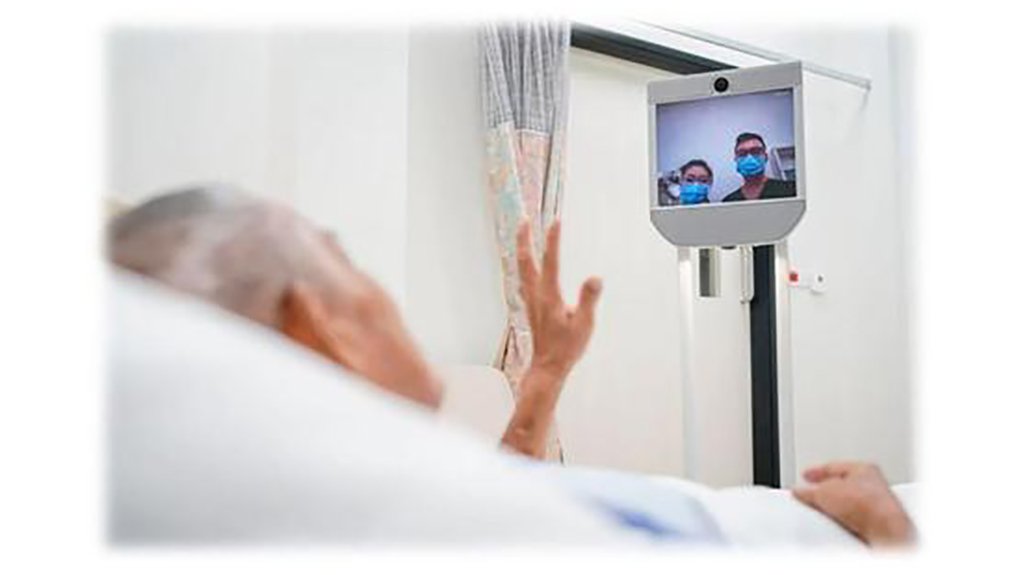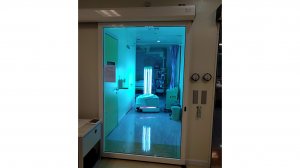Robotics could prove useful as the world, and the healthcare sector in particular, seeks solutions to help in the fight against Covid-19.
Medical robotics distributor Nexmed Healthcare Solutions CEO Jonathan Burger tells Engineering News its UV-D medical robot uses short-wavelength ultraviolet (UV-C) lamps that, in clinically validated studies, provided effective disinfection of a theatre unit, including setting room, in just eight minutes.
It also offers a medical telepresence robot that allows healthcare practitioners to interact directly with patients without the risk of contagion.
The UV-D robot uses eight full-length UV-C lamps with 360° coverage, which operate only in the germicidal wavelength of 253.7 nm. Each lamp generates 5 J a second of UV-C energy. There are always a minimum of four lamps facing any given surface within 1 m, totalling a minimal intensity of 20 J/m2 per second.
It is also fitted with three-dimensional (3D) cameras and proprietary software to carry out its disinfection. The UV-D robot autonomously repositions its UV-C emitter mounted on top of the robot platform within a defined area to negate shadowing and closeness to a surface. This repositioning can be repeated to ensure that maximum UV-C intensity is radiated onto all surfaces and cubic metres of air.
The UV-D robot has a significant global presence including in the Americas, Europe and the Asia Pacific region. It was brought to Africa in September 2019, and its ability to disinfect autonomously reduces the burden on staff and under-resourced facilities, and is, thus, of particular significance in countries with a fragile health system, like those in Africa, Burger says.
The device is used widely across the world, particularly in China and Italy currently as it is able to disinfect large areas in a short time without exposing healthcare providers to the virus.
The UV-D robot can enter a room autonomously and destroy the virus on surfaces and in the air before a member of staff needs to enter. It is able to move less than 1 m from surfaces to ensure most of a room's contents, including walls, ceilings, floors, cupboards and equipment, come into contact with UV-C and are disinfected.
"The UV-D robot is very effective in destroying microorganisms by destroying their nucleic acid and disrupting their deoxyribonucleic acid (DNA) and leaving them unable to perform critical cellular functions. It does this in rapid time with sufficient power to generate between a log 3- and log 6-reduction, depending on the exposure time.
"This creates a near-sterile environment, which could otherwise not be achieved with manual interventions. There are only so many places a human or a cleaning instrument can reach in a typical eight to ten minute cleaning regime," explains Burger.
The robot integrates seamlessly into the standard terminal cleaning processes of healthcare institutions. The UV-D robot is a very low maintenance device and only requires a yearly service, although most institutions prefer that their own technical department be trained and handle the maintenance. Cleaning the device requires a wipe-down with a high-level disinfection solution.
"Additionally, the robots can easily be programmed, even remotely, as is currently done owing to our lockdown situation," he adds.
The UV-D robot works with a preset map and carries out the disinfection autonomously. However, it does require that a human be present to confirm that the area is safe to carry out the disinfection via a pre-inspection checklist built into the tablet.
The UV-D robot has significant interoperability, allowing up to ten devices to be operated by one individual, all while linking and documenting the device’s disinfection routine via a cloud-based platform.
"Public healthcare facilities can be overburdened and under-resourced which can lead to reduced infection prevention and controls. The UV-D robot, therefore, can play a fundamental part in preventing the spread of treatment-resistant superbugs, creating a far cleaner environment and reducing the risk of an outbreak."
The UV-D robot has undergone, and continues to undergo, various clinically validated studies from some of the largest microbiology institutions in the world. The device is reviewed for its clinical ability to irradiate various microorganisms.
To date, the UV-D robot has been tested effective against: methicillin-resistant staphylococcus aureus (MRSA), Enterococcus Hirae, Pseudo. Aeruginosa, Escherichia Coli, (CRE) Klebsiella Pneumoniae, Acinetobacter Baumannii, Candida Albicans and Clostridium Difficile with as much as a log 6 or log 7 reduction (99.9999%).
The virus that causes Covid-19 requires as little as five minutes exposure to UV-C to reduce the virus to near-untraceable amounts, he states.
BeamPro TELEMEDICINE
The BeamPro robot allows doctors to do remote patient inspections while protecting key staff from exposure to pathogens and also reduces the amount of times a healthcare worker has to enter an infected room and be exposed to the virus.
This reduces the burden on personal protective equipment and helps to alleviate the shortage, as healthcare practitioners do not need to put on protective clothes to speak to a patient, highlights Burger.
The BeamPro robot was mainly a commercial product, but has become synonymous with the fight against Covid-19 and instrumental in supporting healthcare workers and families around the world.
The BeamPro robot has a significant telepresence capabilities with 4K resolution providing a very human-like interaction.
"Doctors or nurses often have to do multiple observations of patients and ask them questions which requires the donning of personal protective equipment each time and can increase risk of exposure.
Using the BeamPro robot, healthcare practitioners can either be onsite in a safe location or offsite in a remote location and conduct the same consultation without risk. The BeamPro has high definition audio/visual capabilities allowing healthcare practitioners to sufficiently evaluate the patient," he says.
The fight against Covid-19 faces two significant challenges, with the first being exposure of healthcare practitioners to the virus and becoming infected, which has a drastic effect the the practitioner's health and patient treatment. The second challenge is the significant shortage of personal protective equipment globally.
"Nexmed Health Solutions has not yet installed a BeamPro robot in Africa. The device is, however, used around the world, and in particular we have seen its use against Covid-19 in Alexandra Hospital, in Taiwan, where the BeamPro was modified with tray-table inserts to deliver food and medication to the patient, allowing further reduction in virus exposure.
"We as Nexmed are currently working on an early-stage project to develop and launch a biosensor capable of monitoring a multitude of vital signs via a single patch with accompanying software using artificial intelligence (AI) to assist with early detection and diagnosis, as well as outcomes prediction. These three systems will form part of our telehealth solution," says Burger.
Both the UV-D robot and the BeamPro can be easily and rapidly deployed to assist in firstly preventing the spread of superbugs, and secondly the exposure to superbugs. They can also be deployed in an outbreak crisis to drastically reduce and curb the outbreak and its detrimental effects.
Both robots are manufactured in Denmark by Blue-Ocean Robotics. There is a significant global demand for the UV-D robot currently, but the men and woman of Blue-Ocean Robotics are working tirelessly to manufacture a significant amount of UV-D Robots daily, says Burger.
"We are working closely with UV-D Robots to fast track orders, but we have seen an impact on supply and logistics because of the coronavirus. One of the major areas of impact has been flight schedules, particular the drastic reduction in available flights coupled with the immense increase in costs of these flights while the weaker exchange-rate does not help either."
"Firstly, we appreciate every healthcare provider on the frontline in service to the nation. Their protection, the patient’s protection and every individual who enters a hospitals protection is important. Our devices are saving lives and are a necessity in the fight against Covid-19 and other superbugs.
"We face a global challenge in the fight against antimicrobial resistance and hospital-acquired infections along with pandemics like the Coronavirus, not only now but in the future. The world is moving towards next-generation technology to assist in this fight. An infection prevented is a treatment avoided and we provide the necessary robotic solutions to effectively fight against superbugs," he adds.
The healthcare sector globally is currently seeing the emergence of Fourth Industrial Revolution-enabled healthcare solutions, which is where Nexmed has immersed itself, he highlights.
"We are seeing the development, launch and adoption of disruptive innovation, which is very exciting. This includes robotics in healthcare, including disinfection robots and robots aimed at minimally invasive surgery, which is a category we will later focus on.
"We have also seen various other exciting technologies taking the forefront in healthcare such as, 3D printing, AI-enabled software, virtual- or mixed-reality-enabled capabilities, smart technology, and the Internet of Medical Things."
Healthcare is moving to personalised healthcare, value-based care and healthcare consumerism, where patients will be more engaged with providers across each stage of care, and a big part of the decision making, concludes Burger.
EMAIL THIS ARTICLE SAVE THIS ARTICLE ARTICLE ENQUIRY
To subscribe email subscriptions@creamermedia.co.za or click here
To advertise email advertising@creamermedia.co.za or click here












